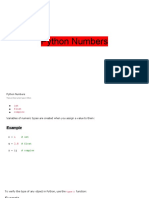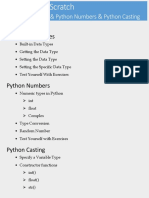2.note - Python Running Errors
Uploaded by
Faisal Saeed Saeed2.note - Python Running Errors
Uploaded by
Faisal Saeed SaeedPython Documentation For This Video
Numeric types (the int and float types)
Numbers
There are two main types of numbers that we’ll use in Python, int and float. For the most part,
we won’t be calling methods on number types, and we will instead be using a variety of
operators.
>>> 2 + 2 # Addition
4
>>> 10 - 4 # Subtraction
6
>>> 3 * 9 # Multiplication
27
>>> 5 / 3 # Division
1.66666666666667
>>> 5 // 3 # Floor division, always returns a number without a remainder
1
>>> 8 % 3 # Modulo division, returns the remainder
2
>>> 2 ** 3 # Exponent
8
If either of the numbers in a mathematical operation in Python is a float, then the other will be
converted before carrying out the operation, and the result will always be a float.
Converting Strings and Numbers
Conversion is not uncommon since we need to convert from one type to another when writing a
script and Python provides built-in functions for doing that with the built-in types. For strings
and numbers, we can use the str, int, and float functions to convert from one type to another
(within reason).
>>> str(1.1)
'1.1'
>>> int("10")
10
>>> int(5.99999)
5
>>> float("5.6")
5.6
>>> float(5)
5.0
You’ll run into issues trying to convert strings to other types if they aren’t present in the string
>>> float("1.1 things")
Traceback (most recent call last):
File "", line 1, in
ValueError: could not convert string to float: '1.1 things'
You might also like
- Decimals, Floats, and Floating Point Arithmetic Tutorial For Python 3 PDFNo ratings yetDecimals, Floats, and Floating Point Arithmetic Tutorial For Python 3 PDF4 pages
- Welcome!: Python - Writing The First Python Code!No ratings yetWelcome!: Python - Writing The First Python Code!13 pages
- Python Objects: After Reading This Chapter, The Reader Will Be Able ToNo ratings yetPython Objects: After Reading This Chapter, The Reader Will Be Able To21 pages
- Python Data Types - Jupyter Notebook_017ae85a1acb61f561c41b1ab55449c7No ratings yetPython Data Types - Jupyter Notebook_017ae85a1acb61f561c41b1ab55449c717 pages
- Python Data Types-Variables and Control structuresNo ratings yetPython Data Types-Variables and Control structures87 pages
- Python - 10 Marks Sol. of Previous PUT_Bharat_AggNo ratings yetPython - 10 Marks Sol. of Previous PUT_Bharat_Agg43 pages
- Everything in Python Is An Object.: Unning CriptsNo ratings yetEverything in Python Is An Object.: Unning Cripts11 pages
- Module 2. Data Types and Data StructuresNo ratings yetModule 2. Data Types and Data Structures27 pages
- Unit - 2 - Data Types, IO, Types of Errors and Control - StructuresNo ratings yetUnit - 2 - Data Types, IO, Types of Errors and Control - Structures18 pages
- Python Programming For Beginners: Python Programming Language TutorialFrom EverandPython Programming For Beginners: Python Programming Language TutorialNo ratings yet
- Introduction to Python Programming: Do your first steps into programming with pythonFrom EverandIntroduction to Python Programming: Do your first steps into programming with pythonNo ratings yet
- Asterisk Advanced Lab Assignment: Building A Basic PBX Extensions SIP Phones Configuration FilesNo ratings yetAsterisk Advanced Lab Assignment: Building A Basic PBX Extensions SIP Phones Configuration Files10 pages
- Strings (The Type) : Python Documentation For This VideoNo ratings yetStrings (The Type) : Python Documentation For This Video2 pages
- LinuxCBT Moni-Zab Edition Classroom NotesNo ratings yetLinuxCBT Moni-Zab Edition Classroom Notes5 pages








































































